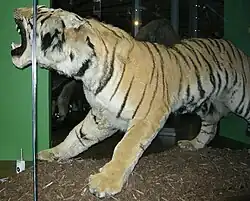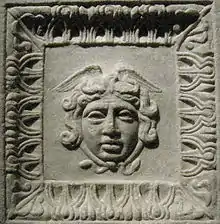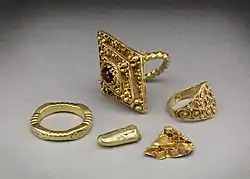Leeds City Museum
Leeds City Museum, originally established in 1819, reopened in 2008 in Leeds, West Yorkshire, England. It is housed in the former Mechanics' Institute built by Cuthbert Brodrick, in Cookridge Street (now Millennium Square). It is one of nine sites in the Leeds Museums & Galleries group.
 Leeds City Museum | |
| Established | 1819; reopened 13 September 2008 |
|---|---|
| Location | Millennium Square, Leeds, West Yorkshire, England |
| Coordinates | 53°48′06″N 01°32′49″W |
| Type | Collection (museum), Heritage centre |
| Public transit access | Leeds railway station, Leeds City bus station |
| Website | Leeds City Museum |
Admission to the museum is free of charge. Special exhibitions are hosted alongside a collection of displays from the Leeds Archive.
History
In 1819, a museum was established in Philosophical Hall, Bond Street, by the Leeds Philosophical and Literary Society, and in 1821 it opened to the public. In 1921, control of the museum was handed to the Corporation of Leeds which later became Leeds City Council. In 1862, Philosophical Hall was rebuilt in Park Row, where its stone portico can still be seen on the west side of the road.[1] In 1941, the museum building and artifacts were badly damaged by bombing.[2][3] In 1965 the museum was closed, and a few exhibits removed to a couple of rooms in the city library in 1966. The oversized Leeds Tiger, the giant moose skeleton and the carved wooden cart took up much of the space. In 1999 the museum went into storage, though researchers and the public could view items by appointment. In 2000, the resource centre at Yeadon opened, under the same appointment-to-view arrangement. In 2001, Leeds City Council bid for National Lottery cash, and in 2004, it was awarded £19.5 million,[4] so in 2005, the Leeds Mechanics' Institute building (designed by Cuthbert Brodrick and built 1865–1868)[5] began to be redesigned as Leeds City Museum, finally to reopen in 2008. It was redeveloped to a design by Austin-Smith:Lord architects and Buro Happold engineers.[6][7] The gallery and exhibit design was provided by Redman Design.[8][9]
The exhibits
While exhibits vary, they are mainly made up of exhibits from Leeds' history. The central hall has a large map of Leeds printed on the floor. There is also a scale model of the Quarry Hill flats.
Life on Earth gallery
This is the natural history gallery, featuring everything from a meteorite to dinosaur dung (coprolite). In 2019, the skeleton of a Long-finned Pilot Whale was hung from the ceiling just outside the gallery.[10] There are several vintage taxidermy-mounts conserved by James Dickinson in 2008, including the Armley Hippo, the Leeds polar bear and the Leeds Irish Elk.[11][12]
.JPG.webp) Leeds polar bear
Leeds polar bear.JPG.webp) Armley Hippo
Armley Hippo.JPG.webp) Leeds Irish Elk
Leeds Irish Elk.JPG.webp) Salford tiger by Harry Ferris Brazenor, 1914
Salford tiger by Harry Ferris Brazenor, 1914
Leeds Tiger

A large, taxidermy-mounted Bengal tiger, this exhibit came to Leeds in 1862. It was shot by Colonel Charles Reid in the valley of Deyrah Dhoon near Mussoorie hill station in Uttarakhand, India in March, 1860. It was originally exhibited at the 1862 International Exhibition in London as a skin - hence its odd shape - before being turned into a taxidermy mount by Edwin Henry Ward (father of Rowland Ward). The Leeds Philosophical and Literary Society received the mounted tiger as a donation from William Gott,[13] and it has been on display to the people of Leeds almost continuously for over 150 years.[14][15][16]
The original tiger has been subject to various myths over the years. The Yorkshire Evening Post said, "We'll never know for certain whether the Leeds Tiger really lived up to its dangerous reputation, but today it sends a shiver down the spines of visitors to Leeds City Museum."[17] However the pelt may now be dangerous after all, in a sense, as the Victorians will have preserved it with arsenical soap.[18][19][20] For over a century it has sagged somewhat, as can be seen in the photograph. Nevertheless, in the early 1860s the tiger was considered an object of beauty:[21][22]
The museum's curator Adrian Norris was quoted in 1979 as saying:[23]
The tiger has always been very popular with the public, and school parties in general, and is one of the few items in the Museum we dare not remove, or cover, for fear of being swamped with complaints from members of the public, who in some cases have travelled many hundreds of miles just to see it.[23]
Ancient Worlds gallery
.jpg.webp)

Here are archaeological items from Leeds and around the world.
- Roman floor mosaic ca 250 CE, depicting she-wolf with Romulus and Remus. This was discovered at Aldborough, North Yorkshire, known to the Romans as Isurium Brigantum.
- Hellenistic Greek tomb doors ca 250 BCE. These are carved in marble, in bas relief.
- The Leeds Mummy. In the 1941 bombing raids, two other mummies were destroyed, but Nesyamun's 3000-year-old mummy survived. It is displayed in the current museum building, alongside a rather striking reconstruction of his face.[24]
- Iron replica of Hellenistic Greek head of Aphrodite. This is a cast replica of the original 1st century BCE head in the British Museum. The original was discovered in 1872 at Satala (now Sadak) in north-eastern Turkey. The eyes were once inlaid with precious stones or paste. Apparently the top of the head was not designed to be empty, like a piece of modern art. It seems that the farmer found it when he hit the top of the head with his axe and damaged it.[25]
World View gallery
In 2014 this gallery began hosting a long-term exhibition called 'Voices of Asia',[26][27] which celebrates the sights, sounds and culture of Asian communities here in Leeds and around the world. The 'faith' element of the display regularly changes. From 2017, the focus was on Buddhism.[28]
Leeds Museums & Galleries has large collection of objects from around the world, and Voices of Asia displays just one aspect of the city's holdings.[29] The Leeds African collections are also significant, especially the sculpture, masks and textiles. Since 2019, most are held at Leeds Discovery Centre, which holds representations of North American beadwork, European folk items and the traditional arts of Oceania.[30]
Leeds Story gallery

The history of Leeds from prehistory to the modern day. One of the key objects on display is the Malham Pipe, originally identified as an Iron Age flute made from bone, its dating has been revised to the early medieval period.[31] The West Yorkshire Hoard is an example of one aspect of medieval Leeds.[32]
Special exhibitions
On the third floor is a gallery space dedicated to a changing exhibition programme. One previous exhibition was 'Beavers to Weavers' looking at things created by creatures.[33]
Collectors Cabinet

Various collections appear here in rotation with a focus on the people behind the objects.
- The Circe bronze by Alfred Drury. This was commissioned from Drury in 1894 by Leeds Art Gallery. It was displaced to Park Square in the 1950s when Victorian art went out of fashion. It was weathered and damaged, but has been restored recently.[34] It was Drury who made the eight beautiful bronze lampholder girls in Leeds City Square, plus the bronze of Joseph Priestley nearby.[35][36]
Associated curators
See also
References
- Leeds Philosophical and Literary Society: About the society
- "Looking back to the night a bomb dropped on Leeds City Museum". Yorkshire Post. 8 February 2018. Retrieved 18 May 2021.
- "Lanuvium and the Leeds Blitz". Leeds Museums & Galleries. 12 March 2021. Retrieved 5 May 2021.
- "Heritage Lottery Fund: History in the Making, 22 September 2005". Archived from the original on 27 April 2006. Retrieved 11 May 2009.
- Banerjee, Jacqueline (22 July 2011). "The Victorian Web". victorianweb.org. The Victorian Web. Retrieved 22 June 2021.
- "Leeds City Museum". austinsmithlord.com. Austin Smith Lord. Retrieved 18 May 2021.
- "A Q and A with Majestic engineers Buro Happold". majesticleeds.co.uk. Majestic Leeds. 5 April 2019. Retrieved 18 May 2021.
- Bond, Chris (12 September 2008). "Long-awaited new museum set to go down in city's history". The Yorkshire Post. Retrieved 10 May 2009.
- "Ilkley firm will design the new City Museum". Telegraph & Argus. 27 June 2003. Retrieved 18 May 2021.
- "Pilot project will piece together Leeds whale's tragic tale". Yorkshire Evening Post. Retrieved 5 December 2019.
- "Voice of James Dickinson conservation officer and taxidermist". webcache.googleusercontent.com/. Lancashire corporate web. 6 June 2008. p. 6. Retrieved 7 August 2021.
- "200-Year-Old Polar Bear Gets Ready For Leeds Museum Opening". culture24.org.uk. Culture 24. 11 January 2008. Retrieved 4 August 2021.
- Anonymous (1862). "Forty-third report of the Council of the Leeds Philosophical and Literary Society". Reports of the Council of the Leeds Philosophical and Literary Society. 43: 9.
- Norris, Adrian (1985). "Notes on the Natural History Collections in the Leeds City Museum. Number 5: The Leeds Tiger". Leeds Naturalists' Club Newsletter. 2:1: 19–20.
- Brears, Peter (1989). Of Curiosities & Rare Things: the story of Leeds City Museum. Leeds: The Friends of Leeds City Museum. ISBN 0-907588-077.
- Roles, John (2014). Director's Choice. London: Scala Arts and Heritage Publishers Limited. p. 29. ISBN 978-1-85759-840-7.
- "Leeds nostalgia: The story of the Leeds Tiger". Yorkshire Evening Post. JP Media. 31 December 2016. Retrieved 8 June 2020.
- Marte, Fernando; Pequignot, Amandine; von Endt, David W. (2006). "Arsenic in Taxidermy Collections: History, Detection, and Management". Collection Forum. 21 (1–2): 143–150. hdl:10088/8134. S2CID 32092718.
- Chestofbooks.com webpage: Arsenical soap.
- Chrystal, Paul (2016). Leeds in 50 Buildings: 9. Leeds City Museum 1819 Park Row. Leeds, England: Amberley Publishing Limited. ISBN 9781445654553. Retrieved 19 May 2021.
- "Leeds Philosophical and Literary Society : Professor Owen's inaugural address". Leeds Mercury. British Newspaper Archive. 17 December 1862. p. 3 col 2. Retrieved 9 June 2020.
- "Visit to the art exhibition in the Leeds Philosophical Hall no.IV". Leeds Mercury. British Newspaper Archive. 2 January 1863. p. 4 col 1. Retrieved 9 June 2020.
- Andrew, Ebony Laura (2013). Interpreting Nature: Shifts in the Presentation and Display of Taxidermy in Contemporary Museums in Northern England (PDF) (Ph.D.). University of Leeds. p. 184. Retrieved 9 June 2020.
- 24dash.com: Sting in the tale of Leeds mummy, by Hannah Wooderson, 3 September 2008. Archived 3 April 2010 at the Wayback Machine
- Britishmuseum.org: Bronze head of a goddess, probably Aphrodite.
- "Voices of Asia". Leeds City Council.
- "Discover a world of Asian wonders behind Leeds museum's doors". Yorkshire Evening Post. 18 April 2014. Retrieved 6 June 2019.
- "Spotlight: the Voices of Asia". Religion in Public. 19 February 2018. Retrieved 6 June 2019.
- "Voices of Asia". Which Museum. Retrieved 25 September 2019.
- "World Cultures Collections". Leeds City Council. Retrieved 6 June 2019.
- Sermon, Richard; Todd, John F.J. (2 January 2018). "The Malham Pipe: A Reassessment of Its Context, Dating and Significance". Northern History. 55 (1): 5–43. doi:10.1080/0078172X.2018.1426178. ISSN 0078-172X. S2CID 165674780.
- "Leeds' Anglo Saxon gold hoard to go on display". BBC News. 8 November 2015. Retrieved 22 November 2020.
- "Beavers to Weavers". Secret Lives of Objects. Retrieved 6 June 2019.
- Culture24: Leeds City Art Gallery Brings Victorian Statue In From The Cold 7 March 2008.
- A sculpture walk in Leeds.
- BBC.co.uk: Moving Statues